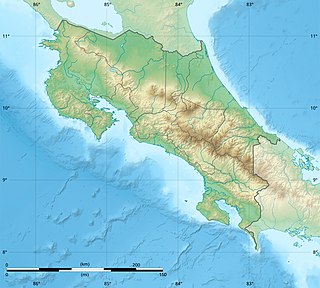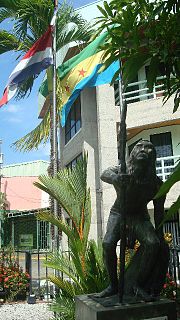Related Research Articles

El Guarco is a canton in the Cartago province of Costa Rica. The head city is in Tejar district.

The Greater Metropolitan Area of Costa Rica, is the largest urban agglomeration in Costa Rica, comprising areas of high population density surrounding the capital, San José, which geographically corresponds to the Central Valley and extended to include the Guarco Valley, where some of the cantons of the Cartago province are located.

José Antonio Lacayo de Briones y Palacios (1679–1756) was a Spanish "intendant" or "intendente" who held the position of governor in two countries in Central America during the Spanish colonial period. He was Governor of Costa Rica from 1713 to 1717 and Governor of Nicaragua from 1740 to 1745. He also held the post of Commander in Chief of the Army and strengthened the defenses of these two countries against foreign invasion.

Tobosi is a district of the El Guarco canton, in the Cartago province of Costa Rica. It is located about 12 miles southwest of the city of Cartago. It is also known as San Juan de Tobosi. St. John the Evangelist is the town's patron guardian.

Tres Ríos is a district of the La Unión canton, in the Cartago province of Costa Rica.

The Ochomogo War was a civil war fought in Costa Rica, the first in its history, and was fought shortly after the country became independent from Spain.
Joaquín Mariano de Oreamuno y Muñoz de la Trinidad was a Costa Rican who led a coup in 1823 that attempted to make Costa Rica part of the First Mexican Empire. A few days later the imperialist forces were defeated by republicans under Gregorio José Ramírez in the Battle of Ochomogo.
The League War was the second civil war of Costa Rica, as a member state of the Federal Republic of Central America. It passed between September and October 1835 in the Central Valley of Costa Rica. Its immediate trigger was the repeal of the "Ambulance Law", the law that established the rotation of the country's capital among the four constituent cities. The most important consequence was the triumph of the city of San José over the cities of Alajuela, Heredia and Cartago, which allowed its consolidation as the capital of Costa Rica.
Diego Gutiérrez y Toledo was the first governor of Nuevo Cartago y Costa Rica Province, established by the Crown of Castile within the Captaincy General of Guatemala in the Viceroyalty of New Spain. Named governor on 29 November 1540, he did not begin acting as such until late 1543 due to a series of difficulties. On 22 November 1543 he founded the village of Santiago in Costa Rica and on 4 October 1544 he founded the village of San Francisco, abandoning Santiago. In San Francisco he hosted several local chiefs, who he later held for ransom. One of the chiefs escaped and another one admitted not having valuables to offer. Consequently, Gutiérrez y Toledo subjected him to servitude, which prompted other indigenous groups to destroy the Spanish colony in retaliation. Gutiérrez y Toledo and the rest of the colonists then marched into the jungle, where they were killed by the natives.

The Huetares were an important indigenous group of Costa Rica, who in the mid-16th century lived in the center of what is now the country. They are also mentioned with the name of güetares or pacacuas. Huetares were the most powerful and best organized indigenous nation in Costa Rica upon the arrival of the Spaniards. During the 16th century, various chieftains dominated from the Costa Rican Pacific coast to the Atlantic Slope. The Spanish chronicles mention a myriad of towns and the kings that ruled them, among them the Garabito Empire, located on the Central Pacific Slope and the Tárcoles River basin, to the Virilla River and the Cordillera Central; the kingdom of Pacaca, in the current canton of Mora, and the Lordship of el El Guarco, in the current Guarco Valley, in the Cartago Province, to the plains of the Central Caribbean and Chirripó. Their culture belonged to the Intermediate Area, and it stood out mainly for their works in stone, such as metates, sculptures, tables and ceremonial altars; and the non-practice of anthropophagy or cannibalism. Its language, the Huetar language, one of the so-called Chibcha languages, became the Lingua franca of the country. Although this language is extinct, it survives in a large number of place names in Costa Rica such as Aserrí, Tucurrique or Barva.

Garabito was an indigenous king of the Huetar ethnic group, who approximately between 1561 and 1574 was a monarch of the Western Huetar Kingdom and its surroundings, in the current territory of Costa Rica. A 1566 document indicates that in 1561 he succeeded his grandfather, although given that in the indigenous kingdoms of the Intermediate Area of Costa Rica, matrilineal succession prevailed, it is more likely that his predecessor was a maternal uncle.
The Eastern Huetar Kingdom, also known as Lordship of el Guarco, is one of the two great kingdoms in which the domain of the Huetar ethnic group was divided in the Central Valley of Costa Rica and at the time of the conquest the king was Correque, son of the feared chieftain El Guarco. Although smaller than the fellow Huetar nation, the Western Huetar Kingdom ruled by Garabito as part of its larger empire. The eastern Huetar territory extended from the banks of the Virilla River to the slopes of the Chirripó in the Tierradentro. The area of the modern Paraiso Canton was governed by the vassal chiefs Abituri and Turichiqui, in addition there were aboriginal settlements in Ujarrás and Orosi that were visited by the Spaniard Ignacio Cota in 1561.
Correque was an indigenous monarch of Costa Rica, king of the Eastern Huetares, who lived in the 16th century. He had several residences and resisted the Conquistadors for some time until he moved one of his courts from Ujarrás to Tucurrique to escape them. He was preceded by El Guarco and succeeded by Alonso Correque.
Pacaca, also called Pacacua, was a Costa Rican indigenous kingdom of the 16th century, whose inhabitants belonged to the Huetar people and culture and whose main seat was in the current Mora Canton, San José Province, Costa Rica, in the place called today with the name of Tabarcia.
National Secondary Route 236, or just Route 236 is a National Road Route of Costa Rica, located in the Cartago province.
National Secondary Route 228, or just Route 228 is a National Road Route of Costa Rica, located in the Cartago province.
National Secondary Route 226, or just Route 226 is a National Road Route of Costa Rica, located in the San José, Cartago provinces.
National Secondary Route 222, or just Route 222 is a National Road Route of Costa Rica, located in the San José, Cartago provinces.
National Tertiary Route 315, or just Route 315 is a National Road Route of Costa Rica, located in the San José, Cartago provinces.
National Tertiary Route 406, or just Route 406 is a National Road Route of Costa Rica, located in the San José, Cartago provinces.
References
- ↑ FERNÁNDEZ, León, Colección de documentos para la historia de Costa Rica, Barcelona, Imprenta Viuda de Luis Tasso, 1a. ed., 1907, vol. VII.
- ↑ FERNÁNDEZ GUARDIA, Ricardo, El descubrimiento y la conquista, San José, Editorial Costa Rica, 1a. ed., 1975.
- ↑ FERNÁNDEZ PERALTA, Ricardo, Pero Afán de Ribera, San José, Instituto Geográfico Nacional, 1a. ed., 1974.